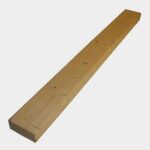Because wood turners make use of thick pieces of lumber, often acquired ourselves in log form, we are often faced with wood that is still high in moisture content, if not soaking wet. This poses quite a problem if the goal is to end up with a clean wood turning project free of cracks and warping.
Wood is a fluid material, expanding and contracting based on the amount of moisture within it. And if the piece of wood in question is a freshly cut log, the amount of movement during drying will be extreme. So how does one deal with this issue when gazing at a beautiful Cherry or Maple log, thoughts of wooden bowls, plates, and hollow forms dancing in your mind?
You “rough turn” the project with thick walls to speed the drying process and eliminate the worst of drying stresses by removing the wet core. The roughed blank may warp and twist some during drying, but once dry and stable may be returned round and finished.
Commercially available blanks pre-cut into neat billets and squares, waxed on all sides to slow down the drying process, can be subject to checking (cracking) also. If I had specific projects in mind for purchased turning blanks, I prefer to rough turn them as well.
Rule #1:
Do the best you can to cut blanks with the same type of grain throughout the piece to optimize successful drying.
Uneven grain structure across a given piece of wood will result in much more stress during drying, more likely to result in either cracking or odd warping as the wood shrinks. So, a piece of wood with a splash of crotch-figure or a knot on one side, with the other side clear, will warp oddly during drying or perhaps crack.
Look at the diagrams attached to this article for illustration of this concept for bowl blanks.
Rule #2:
There is much more warping to pieces turned with the grain oriented in bowl fashion, and much less with grain running lengthwise (e.g. like a baseball bat). This is why roughed out bowl blanks go oval when they dry, requiring finish turning.
However, though spindle oriented wood turning blanks warp less, projects like lidded boxes demand fully seasoned and dried lumber. A fine lidded container will present a beautiful “suction fit” lid that slips on and off cleanly and with precision. This can only happen with perfectly seasoned lumber (and might still vary somewhat during the year as humidity levels rise and fall).
Rule #3:
Know why wood cracks.
Think of wood like an onion with many layers. At first all layers are wet with the same dimensional stresses. It’s stable. However, once it starts to dry from the outside inward, those outer layers squeeze down against the inner layers as they dry. If those stresses reach cracking point before the inner layers dry out also (thus relieving drying stress and becoming stable again), a crack appears, the outer dimension of wood no longer able to hold together.
The act of “roughing out” projects in wet or moist wood is to complete an important component of an overall process:
1) Wood selection and proper cutting
2) Rough Turning to enable successful drying with no, or minimal cracking
3) Proper preparation of the rough blanks for drying
4) Proper (full) drying
5) Finish turning of the project with a now dry and stable roughed-out blank
Cutting Blanks from a Log
Decide where to cut blanks from the log to optimize successful drying.
If you want lidded box blanks or vase/hollow form blanks, slice 2×2, 3×3, 4×4 (or whatever the desired widths are) billets of a desired length.
If you want bowl blanks, or projects using bowl blank orientation for the grain, look at the diagrams in this article for guidance on cut decisions. Maximize to the best of your ability a regularity of grain across the piece, side to side.
Rough Turn the wood blanks.
The rule of thumb is turn the project’s wall thickness to 10% of overall diameter. You can go a tad thicker if you want, but I’d not go any less.
So, a 10″ diameter bowl would be turned to 1″ thick top to bottom (perhaps a bit more at the rim). If it’s a 3×3 spindle oriented blank for a lidded box, turn the blank into a cylinder and core out the body and lid blanks.
The point to roughing your blanks is to core out the centers to promote faster drying with less stress. Though not a 100% guarantee, you are very likely to get a high number of successfully dried blanks that simply need finish turning back to round, netting more projects from a given log.
Wax / Seal the Blanks
Water will evaporate quickest from the end-grain, slowest through the sides. Use a wax-emulsion like Anchorseal (which looks like Elmer’s Glue) and slather it on all end-grained surfaces. Sealing side-grain isn’t necessary as you are trying to even the drying process, not just retard it.
In a pinch I’ve used spray lacquer, elmers glue, even paint when I ran out of Anchorseal. The idea is to apply some kind of brake to water loss through open end-grain.
Place the blank in a grocery store paper bag, or perhaps wrapped in heavy construction paper, wrap it tight, tape it closed, then write the date and type of wood in magic marker on the bag. This is critical as you are now about to place that faceless bundle in your “pipleline” of drying blanks.
Dry the Blank (now part of your pipeline).
The rule of thumb for air drying is 1 year per inch (about).
Air dried wood retains the most pleasant texture during turning once dried. Kiln dried wood is much dustier.
If you do not have a kiln you must learn patience here. As pretty as the piece of wood is, if the project needs to be completed with fully seasoned wood, date the bag, place it on a shelf, and forget about it for the relevant amount of time. Think of it as a work in progress, the establishment of your pipeline. At first it’s frustrating, but after several months to a year or so your pipeline starts to deliver roughed blanks ready for turning.
Keep feeding the pipeline.
Kilns
Many turners make drying kilns to speed the process up substantially. These are not terribly hard to make, the drying elements in some nothing more than 75watt light bulbs. I’ve heard of turners using broken refrigerators as kilns, drilling the necessary ventilation holes and mounting a bulb inside, with racks arranged to promote convection.
If you are interested in building a kiln I recommend you read the how-to article from Dennis Daudelin at Woodturningdesign.com: How to build a Kiln
A Kiln will substantially speed up the drying process from 6 months to a year or so to just weeks, and Dennis did a superb job outlining how to build a “sophisticated” model.
Talk to people at your local turning club and see if any of them use a Kiln, and if so what is it?
Wood Stabilizers and “Soap Soaks”
Another approach to preparing wood for successful drying is to soak the freshly roughed blank with either a commercial stabilizer (PEG 1000) or in a bucket of dish-soap and water for several hours. The idea here is to permeate the wood with solids (e.g. glycerol or polyethylene glycol) that helps to prevent the collapse of wood cells to minimize warping during drying.
This doesn’t speed up drying times, just aids in the stabilization process during drying.
You can check out the article from Ernie Conover from Woodcraft for more specific information on this technique: Soap in your Bowl
Can roughed out wood turning blanks still crack?
Yes, sometimes they do. Nothing is guaranteed with wood and the vagaries of grain, water, and drying. However, roughing out blanks whether straight from a log or from a wet, pre-cut commercially purchased blank, maximizes your ability to get a crack free project out of a thick chunk of wet wood.
And, when all is said and done, never give up. Cracks, inclusions, holes, split knots, are all opportunities as well. I’ve turned beautiful vessels that had a series of knots around them, the knots with triangular splits radiating from their centers. What did I do? I filled those splits with crushed Turquoise and black epoxy, then finish turned the piece.
People loved it, constantly turning the piece around to check out another Turquoise laced knot.
Sources:Wikipedia.org/Wood drying http://en.wikipedia.org/wiki/Wood_drying






